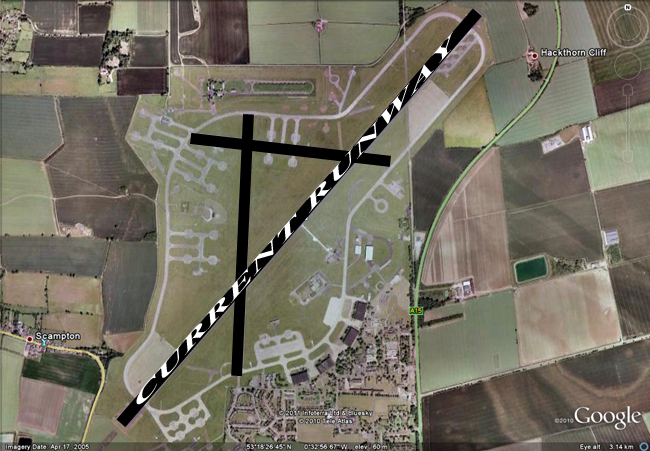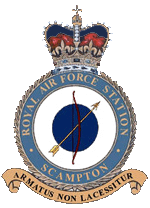Scampton Airfield History

(Map edited to show runways)

© Crown Copyright/MOD 2010
53°18'31.9"N 0°33'9.9"WWartime Runways:
01/19 4500ft x 150ft - 05/23 6000ft x 15ft - 11/29 4200ft x 150ftCurrent Runway:
05/23 9000ft x 200ft
RAF Scampton, just north of Lincoln and adjacent to the A15, needs little introduction; famous as the home of the Dam Busters and the Red Arrows. The airfield was originally a WWI aerodrome known as Brattleby. Following the end of WWI, Brattleby closed and by the end 1920, the hangars and most of the other buildings had gone. The site was one of a number of WWI locations to be surveyed as possible airfield sites under the expansion schemes in the mid-1930s and on 27 August 1936, RAF Scampton, as it was to be known, opened as a bomber airfield under 3 Group.
The airfield was built to the standard Expansion Period design. A grass-surfaced flying field was fronted by four ‘C’ Type hangars, beyond which was the technical site with its permanent brick-built structures. To the east and south of the technical site, but still within the camp, barrack blocks, messes, dining rooms and semi-detached married quarters were constructed, again to permanent, brick-built designs.
When WWII broke out Scampton was within 5 Group and home to 49 Squadron and 83 Squadron, who had arrived at the airfield on 14 March 1938 with their Hinds. Both squadrons had replaced their Hinds with Hampdens by November 1938. The Hampdens were active from the beginning of the war, although the initial targets were restricted to shipping; land targets not authorised until May 1940. In December 1941, 83 Squadron converted to the Manchester with 49 Squadron converting to the same type in April 1942. History has shown the Manchester to have been a poor design with both squadrons suffering losses in flying accidents. It would have been both squadrons’ relief when they received the replacement for the Manchester, the Lancaster in mid-1942.
On 15 August 1942, 83 Squadron moved to Wyton, Cambridgeshire to join the Pathfinder Force and its replacement, 57 Squadron, arrived from Feltwell, Norfolk on 4 September. On 2 January 1943, 49 Squadron left the airfield, moving to Fiskerton, leaving 57 Squadron as Scampton’s sole unit. That was until 23 March 1943, when a secret squadron formed at the airfield and the squadron was numbered 617, becoming famous as the Dam Busters. By now the grass runways at Scampton were in a very poor state and the airfield closed for the construction of concrete runways. On 29 August 1943, 57 Squadron left for East Kirkby and 617 Squadron left the next day for Coningsby.
Scampton reopened in July 1944, having been brought up to Class ‘A’ standard. On 15 October 1944, 53 Squadron arrived from Kirmington, the squadron seeing out the war at the airfield and was disbanded there on 28 September 1945. On 5 April 1945, 625 Squadron arrived from Kelstern, disbanding on 7 October 1945.
Scampton was retained post-war and continued to house bomber units. It played a major role in the Cold War and later became a training establishment. At present it is the home to the Red Arrows the RAF’s aerobatic display team.
| Date | Squadron | Notes |
|---|---|---|
| 1916 | Station opens as Brattleby. | |
| December 1916 | No.33 Sqn | Operating the Royal Aircraft Factory F.E.2b, Avro 504, Bristol Fighter. Left Scampton in June 1918. |
| 1917 | Station re-named as RAF Scampton. | |
| 1920 | RAF Scampton closed. | |
| August 1936 | RAF Scampton re-opens. | |
| October 1936 | No.9 Sqn | Operating the Handley Page Heyford. Left Scampton in March 1938. |
| October 1936 | No.214 Sqn | Operating the Virginia and Handley Page Harrow. Left Scampton in April 1937. |
| June 1937 | No.148 Sqn | Operating the Vickers Wellesley and Hawker Audax. Left Scampton in March 1938. |
| March 1938 | No.49 Sqn | Operating the Handley Page Hampden and Avro Lancaster/Manchester. Left Scampton in January 1943. |
| March 1938 | No.83 Sqn | Operating the Handley Page Hampden and Avro Lancaster/Manchester. Left Scampton in August 1942. |
| September 1942 | No.57 Sqn | Operating the Avro Lancaster. Left Scampton in August 1943. |
| November 1942 | No.467 Sqn | Operating the Avro Lancaster. Left Scampton in November 1942. |
| March 1943 | No.617 Sqn | Operating the Avro Lancaster. Left Scampton in August 1943. |
| August 1943 | Station closed to have new runways laid. Re-opened in September 1943. | |
| October 1944 | No.153 Sqn | Operating the Avro Lancaster. Squadron disbanded in September 1945. |
| April 1945 | No.625 Sqn | Operating the Avro Lancaster. Squadron disbanded in October 1945. |
| December 1945 | No.57 Sqn | Operating the Avro Lincoln and Lancaster. Left Scampton in May 1946. |
| December 1945 | No.100 Sqn | Operating the Avro Lincoln/Lancaster. Left Scampton in May 1946. |
| July 1948 | 28th Bomber G USAF | Operating the Boeing B-29 Superfortress. Left Scampton in October 1948. |
| February 1949 | No.230 OCU | Operating the Avro Lincoln/Lancaster. Left Scampton in April 1952. |
| January 1953 | No.10 Sqn | Operating the English Electric Canberra. Left Scampton in May 1955. |
| August 1953 | No.18 Sqn | Operating the English Electric Canberra. Left Scampton in May 1955. |
| September 1953 | No.21 Sqn | Operating the English Electric Canberra. Left Scampton in May 1955. |
| June 1953 | No.27 Sqn | Operating the English Electric Canberra. Left Scampton in May 1955. |
| May 1958 | No.617 Sqn | Operating the Avro Vulcan. Left Scampton in January 1982. |
| October 1960 | No.83 Sqn | Operating the Avro Vulcan. Left Scampton in August 1969. |
| April 1961 | No.27 Sqn | Operating the Avro Vulcan. Left Scampton in March 1972. |
| November 1973 | No.27 Sqn | Operating the Avro Vulcan. Left Scampton in March 1982. |
| December 1969 | No.230 OCU | Operating the Handley Page Hastings and Avro Vulcan. Left Scampton in September 1981. |
| February 1975 | No.35 Sqn | Operating the Avro Vulcan. Left Scampton in March 1982. |
| February 1983 | Red Arrows | RAF Display Team. Left Scampton in 1996. |
| 1984 | CF School | Left Scampton in 1996. |
| 1996 | RAF Scampton closed. | |
| December 2000 | RAF Scampton re-opens. | |
| January 2001 | Red Arrows | RAF Display Team. |
